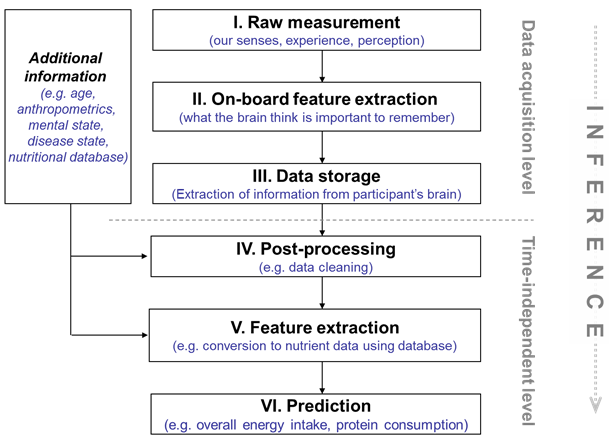- Nutrients, foods, and diets
- Dietary adequacy and nutritional requirements
- Diet variation, quantification, and misreporting
- Food composition data and databases
- Data processing
- Introduction to subjective measures
- Estimated food diaries
- Weighed food diaries
- 24-hour dietary recalls
- Food frequency questionnaires
- Diet checklists
- Diet histories
- Technology-assisted dietary assessment
Introduction to subjective measures
- Subjective methods use responses from a participant to estimate aspects of diet, physical activity, and anthropometry.
- Information about diet, physical activity and anthropometry derived from the participant's senses, experiences, and perceptions is stored in memory.
- The purpose of a subjective method is to extract these data as accurately as possible.
- Extracting pertinent information through subjective methods is a very difficult task; at present there is no subjective method suitable for all purposes and populations.
Diet, physical activity, and anthropometry have multiple complex dimensions and, as a result, many instruments have been designed for a variety of purposes. Subjective methods rely on the information about these dimensions first being stored in the memory and the individual being able and willing to report these details accurately.
Therefore, an important disadvantage of subjective methods is their potential to be influenced by biases, such as recall bias and social desirability bias. However, subjective methods generally have the following important advantages:
- Affordability
- Ease of use
- Non-invasiveness
- Ability to capture qualitative dimensions of context and type
- Flexible means of implementation (e.g. electronic device, paper and pencil, online)
- Suitability for large studies
It is possible to capture detailed data using subjective methods, but there is typically a trade-off between detail and participant burden.
Typically, dietary assessment aims to answer the following broad questions:
- What was eaten?
- How much was eaten?
- How often is this eaten?
Diet consists of multiple quantitative and qualitative dimensions; there is no method that can capture each of these simultaneously and with accuracy. Instruments vary greatly in terms of the scope and detail with which they measure diet and ability to answer the above questions.
Subjective assessment of diet requires the individual (or proxy-reporter) to report what they consume during a specified time period, which can range from as little as one day to a lifetime.
The utility of dietary assessments depends on the aims. For example, different methods may be selected to assess an average dietary exposure in a study population or to assess average habitual diet of each study participant. The latter is more demanding than the former. Dietary assessment on a single day may be good enough to capture average dietary habits in a population, but not enough to capture habitual diets of individuals. Generally, subjective methods with shorter time frames require multiple measurements to capture habitual diet.
Dietary analysis using subjective methods typically involves the following two steps:
- The assessment of food consumption using dietary assessment tools
- The conversion of reported intakes into nutrient data
An example of the stages of inference in predicting a dietary target variable through subjective measurement is shown in Figure D.6.1.
Dietary assessment also captures diverse dietary characteristics. Examples include frequency of snacking during watching TV, frequency of skipping breakfast, frequency of having meals alone, a period of dieting for weight loss, degree of addiction to a certain food group, and the monetary cost spent for a diet. Depending on societal or psychiatric questions, tools can be diverse. In this website, only standard ones are covered. For questions related to any special objective(s), please contact us.
Dietary data from any dietary assessment can be processed to investigate dietary patterns in a study population. Such ‘dietary pattern analysis’ may assess: 1) adherence to dietary guidelines or specific dietary patterns (e.g. Mediterranean diet) and 2) a unique dietary pattern representing combination of dietary consumption existing in a given study population.
Information from a dietary assessment can also be used to provide feedback to study participants. Feedback may include reported profiles of diet, adequacy of nutrient intakes, a degree of adherence to dietary guidelines, and other information.
Figure D.6.1 Example of stages of inference for a subjective method of dietary assessment.
Adapted from: [1].
In this website of DAPA, subjective methods for dietary assessment are grouped into the following categories, with an additional page on technology-assisted dietary assessment:
- Corder K, Ekelund U, Steele RM, Wareham NJ, Brage S, Assessment of physical activity in youth. J Appl Physiol, 2008;105:977-87, PMID: 18635884
